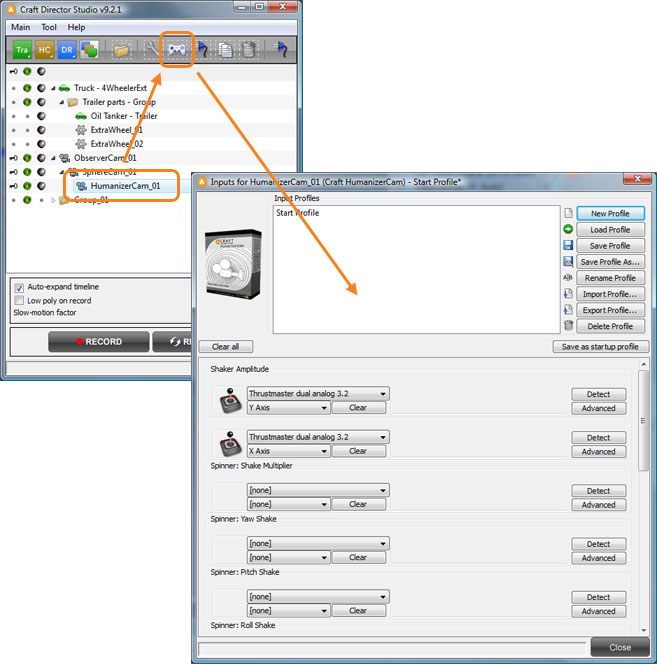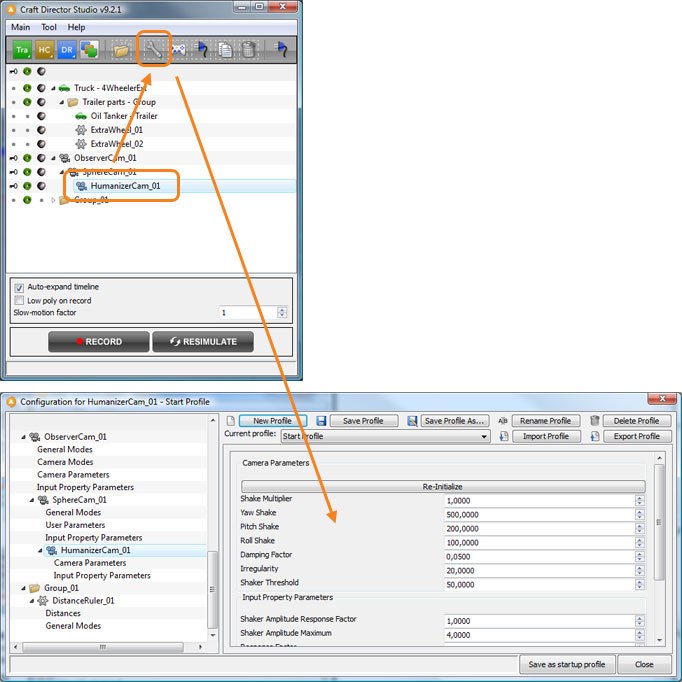
Using Craft ZoomAndFocusCam
 Optimizing the scene Optimizing the scene
It’s wise to optimize the scene before starting to recording the animation. The scene is optimized by decreasing the amount of polygons shown during the recording. This is achieved by hiding objects not crucial to the part of the scene to be animated. Another tip is to use Craft Bounding Poly, which temporary lowers the amount of polygons for selected objects and allows for a smoother recording.
|
- Create a Craft ZoomAndFocusCam.
- Configure the Input settings for Craft ZoomAndFocusCam (using an analog input device is recommended).
To configure the Input settings for Craft ZoomAndFocusCam select Craft ZoomAndFocusCam in the tool tree list and click the Input settings button. This will open the input settings window for Craft ZoomAndFocusCam.

- Link/parent the focal targets FocalTarget_1 and FocalTarget_2 to the objects to be focused on, or simply place them in the relevant locations (i.e. if you are focusing on stationary objects).

- For best results animating Craft ZoomAndFocusCam itself, it is recommended that you use Craft ZoomAndFocusCam in conjunction with other Craft Director Studio’ cameras.
- If the scene is too complex, the recording will be slow and choppy. It is therefore advisable to hide the high-poly models until after the animation is finished.
- Press Record in Craft Director Studio’s main window in order to start the recording. Maneuver Craft ZoomAndFocusCam with the input settings configured earlier.
- Craft ZoomAndFocusCam’s motion will be recorded and key-framed during the recording. Press Stop to end the recording.
- If the recording is not satisfactory drag the timeline back to any position desired and continue to rerecord from there. This way the entire recording does not have to be redone.
- By using the Countdown feature, it’s possible to pick up the input device and get ready before the recording starts.
- To make it easier to maneuver tricky parts in the animations, use the Slow-motion factor in Craft Director Studio’s main window.
- Configure Craft ZoomAndFocusCam so that it uses Depth of View, otherwise it won’t have the desired focus effect. Here’s how:3ds Max:
- Select Craft AutofocusCam’s camera and open the Modify panel.

- Activate the Multi-Pass Effect and then choose Depth Of View.
- Configure the Depth of Field parameter f-stop at the desired depth of focus.

Maya:
- Select Craft ZoomAndFocusCam’s camera and open the Attribute Editor.

- Go down to the Depth of View and check the box to activate Depth of View.
- Configure the Depth of Field parameter f-stop at the desired depth of focus.

- Render.
Back to top
Focal Position
Moves the focus point of Craft ZoomAndFocusCam point of focus (CurrFocalPoint) between the FocalTarget meshes.

Zoom
Makes Craft ZoomAndFocusCam zoom in and out.
Spinner…
Spinners enables the change of parameter values with an input controller in real time.
Back to top

General Modes
Hide Helpers
Hides the helper objects.
Hide Helpers during Recording
Hides the helpers during recording.
Hide Camera
Hides the camera.
Focus Parameters
Use spherical focal surface
Use this parameter to give the camera a spherical focal point instead of a plane.

Zoom Parameters
Maximum FOV
Determines the maximum for zooming out. A higher FOV value = ability to zoom out farther.
Minimum FOV
Determines the maximum for zooming in. A lower FOV value = ability to zoom in more.
Integration Speed Exponent
A dynamic change speed value that adjust the FOV change speed so that it doesn’t move too fast when you’re working with low FOV values. The change speed = c*Input*(180-curr_FOV)^exponent.
Input Property Parameters
Focal Position Response Factor
How fast the Craft ZoomAndFocusCam’s focal point reacts.
Focal Position Change Limit
How fast the Craft ZoomAndFocusCam’s focal point can move (units/frame).
-
Focal Position Keep Binary State (0) Focal Position Integrate (0)
The focal point (CurrFocalPoint) will move between the two FocalTarget meshes at a non-constant speed – i.e. you control it manually in real time. It can stop anywhere between the two points, but cannot move beyond the FocalTarget_1 or -1 point.
-
Focal Position Keep Binary State (1) Focal Position Integrate (0)
When only the Focal Position Keep Binary State box is checked, the focal point (CurrFocalPoint) moves automatically between the FocalTargets. The movement between points will take the form of acceleration/deceleration depending on what response factor has been chosen (lower response factor = more gradual acceleration/deceleration).

-
Move the control forward, and the focal point will move from FocalTarget_1 to FocalTarget_2.
-
Move the control backwards and the focal point moves back to FocalTarget_1.
-
Move the control backwards again and the focal point will move to the -1 point.
-
Focal Position Keep Binary State (1) Focal Position Integrate (1)
When both Focal Position Keep Binary State and Focal Position Integrate are checked, the focal point simply begins moving at a constant speed once the control is moved.
-
Move the control forward, and the focal point will begin moving at a constant speed forward – it will continue endlessly until it receives other input.
-
Move the control backwards and the focal point will stop.
-
Move the control backwards again and the focal point will begin moving backwards at a constant speed until it receives other input.
-
Focal Position Keep Binary State (0) Focal Position Integrate (1)
When only the Focal Position Integrate box is checked, the focal point will move freely on the line between the two FocalTarget meshes. This allows you to move the focal point manually – at a non-constant speed. You can create the illusion that you have manually focused the camera – over compensating slightly and then bringing the focal point back to the right position.
Zoom Response Factor
How fast Craft ZoomAndFocusCam’s zoom reacts.
Zoom Change Limit
Maximum speed for zooming (units/frame).
-
Zoom Keep Binary State (0) Zoom Integrate (0)
The FOV will shift between the maximum and minimum FOV values at a non-constant speed – i.e. you control it manually in real time. The FOV can remain at any value between the maximum and minimum values, but cannot move beyond them.
-
Zoom Keep Binary State (1) Zoom Integrate (0)
When only the Zoom Keep Binary State box is checked, the FOV moves automatically between the minimum and maximum FOV values. The zooming will take the form of acceleration/deceleration depending on what response factor has been chosen (lower response factor = more gradual acceleration/deceleration).
-
Move the control for Zoom forward, and the FOV will change from the minimum to the maximum.
-
Move the control for Zoom backward, and the FOV will change from the maximum to the minimum.
-
Zoom Keep Binary State (1) Zoom Integrate (1)
When both Zoom Keep Binary State and Zoom Integrate are checked, the FOV simply begins changing at a constant speed once the control is moved.
-
Move the control forward, and the camera will begin to zoom in. It will continue endlessly until it receives other input.
-
Move the control backwards and the zooming will stop.
-
Move the control backwards again and the camera will begin to zoom out at a constant speed until it receives other input.
-
Focal Position Keep Binary State (0) Focal Position Integrate (1)
When only the Zoom Integrate box is checked, the FOV can change freely. This allows you to zoom in and out manually – at a non-constant speed. You can create the illusion that you have manually zoomed in on an object – over compensating slightly and then bringing the zoom back to the desired value.
Back to top


 Optimizing the scene
Optimizing the scene







